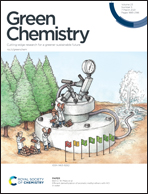Achieving environment-friendly production of CsPbBr3 films for efficient solar cells via precursor engineering†
Abstract
CsPbBr3 films have attractive applications in resistive switching memory, light-emitting diodes, photodetectors, and especially in perovskite solar cells (PSCs) because of their high stability and ease of fabrication under open air conditions. However, toxic solvents are usually employed to prepare CsPbBr3 films in these devices and pose potential threats to the health of manufacturers and the environment. Here, we develop a novel approach to achieve environment-friendly production of high quality CsPbBr3 films using water-soluble precursors of Pb(NO3)2 and CsBr in combination with phenethylammonium bromide (PEABr). In this approach, only green solvents of water and 2-propanol (IPA) are used to prepare CsPbBr3 films. After integrating into a solar cell with a typical configuration of FTO/TiO2/CsPbBr3/carbon, the best solar cell exhibits a power conversion efficiency (PCE) of 6.25% and has excellent stability in open air. This work not only provides a new approach to prepare high quality CsPbBr3 films, but also addresses the solvent toxicity during the fabrication of CsPbBr3 films, which makes it have extensive applications toward environment-friendly production of various CsPbBr3-based optoelectronic devices.



 Please wait while we load your content...
Please wait while we load your content...